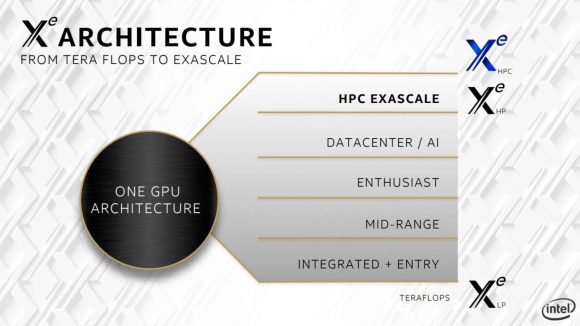Slides said to outline the Intel Xe GPU architecture have been gawked at by Digital Trends. Within these aged docs, likely from early 2019, it’s suggested that Intel planned a 512 EU card with a 400/500W TDP. Great if you run a data centre, perhaps. But forget all that server nonsense, it would appear that a 75/150W, and maybe even a 300W, graphics card will be safe for client consumption.
Let’s be clear from the get-go, these specifications are unconfirmed. They are likely to remain as such for some time, too. We’re not expecting to hear anything more about Intel Xe until GDC mid-March, and unless Intel has some surprise announcement in the meantime, these leaks are going to remain unverified until then at least… if not sometime after that.
Similarly, the slides reference “product overview proposal level 2,” a planning stage for upcoming product reportedly back in early 2019 (via Andreas Schilling on Twitter). That would put these “new” slides way back in the development timeline, and a lot could’ve, and probably has, changed since then.
With that out the way, onto the tentatively juicy and out-of-date details. Intel lists seven GPUs within the “ATS Enablement Platform” (Arctic Sound). There are four SDV (Software Development Vehicle) GPUs and three RVP (Reference Validation Platform) GPUs listed. Both encompass one, two, and four tile configurations (each tile comprised of 128 EUs).
| Type of card | Tiles | TDP (Watts) | Input voltage | Form factor |
| RVP | 1 | 75 or 150 | 12V | Custom PCIe |
| 2 | 300 | 12V | Custom PCIe | |
| 4 | 400/500 | 48V | Custom PCIe | |
| SDV | 1 | 75 | 12V | Standard PCIe |
| 150 | 12V | Standard PCIe | ||
| 2 | 300 | 12V | Standard PCIe | |
| 4 | 400/500 | 48V | Standard PCIe |
The top part referenced is a 512 EU 500W GPU fit with HBM2e memory and PCIe 4.0, and will reportedly run on 48V input. That’s server-grade gear, and not to be meddled with by the likes of you and me. It also seems likely that Ponte Vecchio on 7nm has replaced this GPU in the lineup since these plans were drawn up.
Rather, it would appear the single tile part is intended for us mere mortals in the client segment, a later slide suggests. Compatibility with Wilson Point (most codenames ending in “Point” are Intel chipsets) also suggests client-grade motherboard compatibility for Intel’s one-tile Intel Xe graphics cards. The 300W two-tile GPU is also listed as compatible with Wilson, but later slides suggest only the 128 EU chip will trickle down into client PCs.
The proposed two-tile GPU would make for a thirsty animal. At 300W, it would be placed well above even Nvidia’s Titan RTX in terms of raw power draw and necessary thermal solution. Performance would have to be pretty spectacular to justify that energy bill, too.
It’s not wholly clear how Intel Xe-LP, Xe-HP, and Xe-HPC microarchitectures (subdivisions of Intel Xe as a whole) fit into the stack. Xe-HPC is equipped with heaps of features fit for data centre number-crunching, and is set to arrive in 2021 with Ponte Vecchio. Xe-LP is set for DG1, that we know. But Xe-HP is a bit of a mystery. One would assume DG2 is destined on the Xe-HP microarchitecture, but that may not be the case.
The information provided today doesn’t make things much clearer, and that’s likely because a whole lot has changed since its internal distribution. Even the Arctic Sound codename has since slipped out of circulation.
Intel displayed a reference SDV graphics card, Intel DG1 on the Xe-LP microarchitecture, over at CES 2020, fit with a glossy shroud and single-fan cooler. Its performance, however, was not to be taken as representative of the real deal – or at least that’s what we’re told. The SDV managed roughly 30fps on low in Warframe.
Not what you were hoping for? While that’s subject to change, all signs point towards DG1 existing as a mobile discrete GPU part to sit alongside Intel Tiger Lake CPU graphics.

